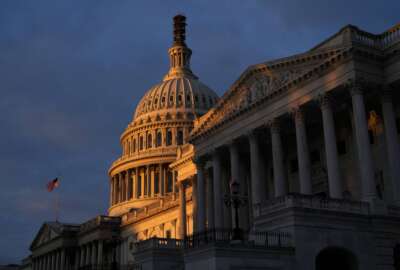
Treasury will invite more feedback on USASpending.gov
The Treasury Department is looking for more feedback on USASpending.gov, an online portal that documents agencies' financial information. It's one step Treasury is...
The Treasury Department will soon start looking for more feedback on USASpending.gov.
“We are interested in what the next generation of USASpending will look like,” David Lebryk, fiscal assistant secretary of the Treasury Department, said at the Data Transparency Coalition’s 2015 conference in Washington Sept. 23. “We’re asking you to join us in that. We don’t have to have this in place until May of 2017, but it’s not too early to start.”
Lebryk said he expects the invitation will come out in the next week or so.
The department wants the public to get involved in the discussion and comment on the portal’s visualization and navigation tools.
The Treasury Department runs USASpending, the portal where the public can find financial information for federal agencies, and oversees DATA Act implementation with the Office of Management and Budget. But complaints about the site’s mapping and navigation — and major problems with the data itself — have plagued USASpending well before Treasury took over the site from the General Services Administration about a year ago.
There are some limitations to the data on USASpending, Lebryk acknowledged. On USASpending now, users can see the general program areas where the Transportation Department and Federal Highway Administration, for example, are issuing their grants. But in the future, the public will be able to see specific contracts and dollar amounts for each one.
“It should help allow us not only to drill down in a vertical way, but also ultimately allow us to look horizontally across government and look at how spending is across the government and program areas,” he said.
Progress on DATA Act implementation
Treasury and OMB have made progress finalizing 57 governmentwide data standards. But Lebryk said there’s still more work to do.
“I don’t want to say they’re complete and done,” he said. “‘Place of performance’ is a difficult issue. It means two different things in two different communities. ‘Program’ means lots of different things in different communities. So we’re really going to have to work on those things, and we’re committed to doing that.”
But the Obama administration and Congress can’t take their eyes off open data once standards are defined and agencies finish their eight-step implementation plans, said Rep. Darrell Issa (R-Calif.), one of the DATA Act’s co-sponsors. He urged agencies to meet their deadlines and carry open data initiatives past this initial “opening round.”
“If any timeline is offered to you this year and it’s one day after Jan. 20, 2017, then it’s not a timeline, it’s a dream.” Issa said. “We don’t need dreams. We don’t need promises. We need, what will you deliver before Jan. 20, 2017?”
Issa said some agencies are already far along toward getting their data in the right format, but others have a long way to go.
“Until they tell us what they don’t have and what they need, my assumption is that it’s a lack of leadership,” he said. “When you hear that from an agency, the only question I’d ask you to say is what have you done to find out what your capabilities are, what they’re not and how you’re going to get from here to there? You’ve been told where you have to end up. Do you know where you are? Have you done an assessment of where you are, or do you just say we can’t do it?”
Lebryk said individual agencies are engaged and making strides in their implementation plans.
“They put small teams together, they’re looking at the standards, they’re understanding the concepts,” he said. “We have a couple pilots that are showing great promise — reusable code and those kinds of things — that are moving along. If we may not have all the answers today, I’m feeling pretty good [that] we have a structure, a governance process and the right people in place to answer the really tough questions.”
HHS, SBA unlocking more data
Some agencies are beginning to find new uses for financial data they already have, and they’re seeing some early success from individual pilot programs.
The Health and Human Services Department is also looking for feedback on its DATA Act Section 5 Pilot projects. The agency’s Grant Information Gateway, for example, describes how federal grant lifecycles work.
“We know it’s working, because we’re getting approximately 55,000 hits a month right now, and I don’t think it’s been advertised a whole lot,” said Mike Peckman, director of the DATA Act Program Management Office at HHS. “That’s pretty big.”
With help from Treasury, the Small Business Administration is working on a pilot for the SBA Grants Data Explorer. It keeps track of where the agency is making awards, what program those grants are a part of, and how much the grant recipient has used over time.
Tim Gribben, deputy chief financial officer at the Small Business Administration, said he’s tapping into information that wasn’t always readily available to him.
“I never had this linkage before,” he said. “From the CFO’s perspective, I can only see anything at the program level, but I can never get down to an award level like this. I can never see where the awards were made. I’d have to go to the program office and pull it out of their source system.”
Copyright © 2025 Federal News Network. All rights reserved. This website is not intended for users located within the European Economic Area.
Nicole Ogrysko is a reporter for Federal News Network focusing on the federal workforce and federal pay and benefits.
Follow @nogryskoWFED



